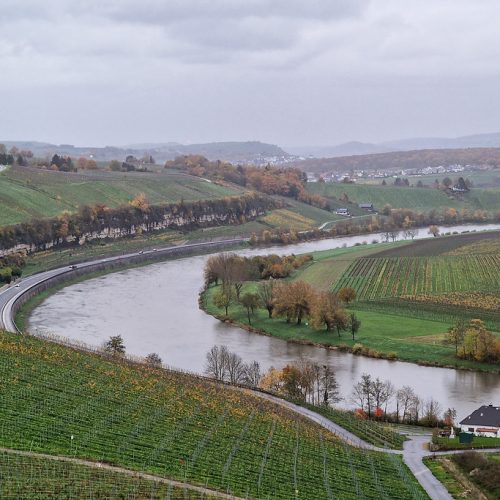The Moselle Valley, located in north-eastern France, south-western Germany, and eastern Luxembourg, is an appealing region known for its magnificent vistas along the Moselle River. Let’s take a trip through this enthralling region, where luscious vineyards and quaint villages paint a stunning picture.
Taking on the Multinational River
The Moselle River flows smoothly through the Moselle Valley, forming a natural boundary between three countries: France, Germany, and Luxembourg. Furthermore, it contributes to the drainage of a fourth nation, Belgium, adding to the region’s unique geographical significance.
A Taste of Moselle Wine Tradition Reveals a Nineteenth-Century Legacy
The Moselle Valley has been associated with high-quality white wine production since the eighteenth century. The word “Moselle wine” is heard in three nations’ vineyards, with Luxembourg claiming its heart as a major participant in the wine business. The German Mosel area also has a viticultural legacy, while France has several notable vineyards along the Moselle.
Table of Contents
Beyond the Grapes: The Thriving Tourism Industry
Making an Adorable Rural Getaway
The Moselle Valley has won not just recognition for its wine but also a place in the tourism industry. The location has become a draw for travelers looking for a peaceful vacation, evoking the allure of a rural paradise. The tourist business grows most significantly in the Moselle Valley’s Luxembourgian and German portions.
The Enclave of Luxembourg: Where Beauty Knows No Bounds
Luxembourger Landscape Mapping
Luxembourg’s part of the Moselle Valley corresponds to the cantons of Grevenmacher and Remich’s center and eastern areas. Despite the absence of significant metropolitan centers, the valley is home to attractive villages such as Grevenmacher, Mondorf-les-Bains, Remich, and Wasserbillig. These settlements, each with a population of over 2,000 people, add to the rich tapestry of Luxembourg’s Moselle Valley.

Discover Luxembourg’s Best Wineries in the Moselle Valley
Caves Saint Martin
Since its founding in 1919, Caves St. Martin has been a steadfast advocate of the vintage winemaking method that the Benedictine monk Dom Perignon invented.
This Champagne House has continuously led the way in the quest for quality, protecting ancestors’ knowledge, and elevating the “Perle de la Moselle” region’s stature. Caves St Martin has been more and more focused on producing superior sparkling wines throughout time, which is a credit to the skill of its winegrowers. The house has been exporting these magnificent sparkling wines for a century from its eponymous caves, which are thoughtfully tucked away on a limestone plateau just below ground.
An Enchanted Wine World
Given its tiny size, Luxembourg becomes a major participant in the wine industry. The soil’s particular composition and temperature make the area perfect for growing grapes. Luxembourg has developed into a sanctuary for winemakers, with more than 4,000 caverns for the maturing and storage of wine.
The climate, which is characterized by long growing seasons, warm winters, and little rainfall, helps grapes ripen fully. This leads to naturally high-sugar grapes, which create the ideal conditions for producing outstanding wine.
Producing Superior Wines
Caves Saint Martin is a well-known wine company in Luxembourg that is committed to creating wines of the highest grade. With great enthusiasm and sincerity, Caves St. Martin welcomes the new age and prepares itself to meet difficulties head-on while maintaining its rich winemaking legacy.
The winery is persistent in its pursuit of greatness because it aspires to support distinctive terroirs and preserve fundamental principles.
To sum up, Caves St. Martin represents a history of custom, dedication to excellence, and a strong bond with the Luxembourg region. The vineyard continues to be a symbol of honesty and enthusiasm in the making of timeless sparkling wines, even as it navigates the changing terrain.
Caves POLL-FABAIRE, Wormeldange
In the heart of Luxembourg’s gorgeous Moselle Valley, Caves POLL-FABAIRE, a famous producer of superb Crémants de Luxembourg, is a fascinating trip for wine enthusiasts. This prestigious restaurant, which opened in 1991, has become a sanctuary for visitors looking for a stimulating study of sparkling wines.
A Craftsmanship Tradition
Caves POLL-FABAIRE date back to the 1930s, when the Art Deco-inspired edifice was built. This architectural treasure exemplifies the region’s rich past and is a tribute to the exquisite craftsmanship that has gone into making great Crémants throughout the years.
Cultivating Excellence in Crémant Production
The production of Crémants de Luxembourg, which is subject to strict regulations, calls for a lot of care and love. The core of these sparkling wines, carefully picked Pinot Blanc and Chardonnay grapes, go through a classic double-fermentation method. This precise process produces an energetic joy that captures the spirit of the terroir of the Moselle Valley.
International Recognition: Winning the Tastes of Wine Connoisseurs
The trademark Crémants of Caves POLL-FABAIRE has received international recognition, enchanting the discriminating tastes of wine enthusiasts worldwide. These sparkling wines have received countless acclaim for their perfect blend of crisp acidity, fruity aromas, and delicate bubbles, cementing their place as Luxembourg’s pride and pleasure.
Beyond the Production: An Exciting Visitor Experience
Caves POLL-FABAIRE shares its enthusiasm for Crémants with its visitors, providing a one-of-a-kind and magical experience. Guided tours dive into the complexities of Crémant production, showcasing the passion and knowledge required to create these extraordinary wines. Guests embark on a journey of discovery as they descend into the labyrinthine tunnels and aged caverns, enjoying the workmanship and care behind each bottle.
A Flavor Symphony: A Memorable Tasting Experience
The tourist experience concludes with a pleasant tasting session in which guests may sample the superb Crémants alongside a selection of local cheeses and delights. The atmosphere is welcoming and pleasant, generating a sense of community and a shared appreciation for the region’s gastronomic wonders.
A Cultural Jewel: Loving the Moselle Valley Spirit
Caves POLL-FABAIRE is a cultural jewel that symbolizes the essence of the Moselle Valley. The winery’s steadfast dedication to heritage, workmanship, and quality has made it a must-see destination for wine enthusiasts and discriminating tourists alike. A visit to Caves POLL-FABAIRE is an invitation to go on an adventure, immersing oneself in the world of Crémants and tasting the essence of Luxembourg’s wine tradition.
Domaine L&R Kox
Domaine L&R Kox, a family-run winery famous for its excellent wines and unique approach to winemaking, is situated among the lovely vineyards of Remich, Luxembourg. Laurent Kox founded the winery in 1977, and it has since gained a reputation for producing high-quality wines that highlight the distinctive terroir of the Moselle Valley.
Using Tradition While Embracing Innovation
Laurent Kox, the creative driving force behind Domaine L&R Kox, has always been at the forefront of wine industry innovation in Luxembourg. He was the first private winemaker in Luxembourg to produce Crémant, a sparkling wine that has since become a national treasure, in 1977. He has also been instrumental in restoring the traditional method of maturing wines in kvevris, ancient Georgian clay amphoras that lend a distinct depth and richness to the wines.
A Focus on Quality and Sustainability
Throughout its existence, Domaine L&R Kox has been committed to quality and sustainability. Laurent Kox’s viticultural enthusiasm has led him to diligently nurture his vineyards, ensuring that the grapes are cultivated under optimal circumstances to reveal the full potential of the terroir. The winery also uses sustainable agricultural methods to reduce its environmental impact and ensure the vines’ long-term health.
A Wide Selection of Wines to Please Every Palate
Domaine L&R Kox offers a diverse range of wines that reflect the Moselle Valley’s diversity of varietals and flavors. Their Rieslings, the aristocratic white wines of Luxembourg, are noted for their grace, refinement, and minerality. Pinot Blancs have a good mix of richness and acidity, but Auxerrois wines have flowery aromas and are smooth on the palate. Gewürztraminers, with their bright aromatics and sweetness, provide a welcome counterpoint to the region’s drier varieties.
A Wine Enthusiast’s Paradise
Domaine L&R Kox is a paradise for wine lovers looking to immerse themselves in the world of excellent wines. The vineyard offers guided tours that dive into the subtleties of winemaking, giving guests a better understanding of the passion and knowledge that go into each bottle. Tasting sessions allow you to sample the winery’s broad selection of wines alongside local cuisine, providing a fascinating and enriching experience.
A Legacy that Enriches Luxembourg’s Wine Landscape
Domaine L&R Kox is a monument to Luxembourg’s wine industry’s lasting history of innovation and tradition. The winery continues to produce great wines that capture the soul of the Moselle Valley under the direction of Laurent Kox and his family. It is a location that invites wine enthusiasts to explore the genuine essence of Luxembourg’s winemaking legacy, where innovation and tradition coexist to create a symphony of flavors and sensations.

Three Delicious Dishes to Try in the Moselle Valley Wine Area
Judd mat Gaardebounen – Smoked Collar of Pork With Broad Beans
Judd mat Gaardebounen, which translates as “smoked pork with broad beans” in Luxembourgish, is a robust and traditional meal that exemplifies the Grand Duchy of Luxembourg’s culinary culture. This rustic meal, which is frequently prepared during Lent and on special occasions, is a monument to the region’s rich agricultural tradition and the deft preparation of local products.
History and Tradition
Judd mat Gaardebounen may be dated back to the 16th century, when smoked pork collar, called “judd” in Luxembourgish, was a popular rural meal. The recipe acquired popularity as a method to use the plentiful broad beans, or “gaardebounen,” cultivated in Luxembourg’s rich valleys. Judd Mat Gaardebounen became a culinary symbol of the country throughout time, signifying basic yet tasty cuisine that has lasted the test of time.
Signature Ingredients and Methods of Preparation
The perfect mix of tastes and textures is the secret to Judd Mat Gaardebounen. The dish’s base is the smoked pork collar, which has a deep, smoky scent and soft flesh. Broad beans, cooked until soft and then sautéed with butter and fragrant herbs, give a brilliant green contrast and a hint of earthiness to the dish.
Judd Mat Gaardebounen preparation
Judd mat Gaardebounen preparation is a simple yet time-honored method. To eliminate excess salt and provide moisture, the smoked pork collar is first cooked in water. It is then cooked in a savory broth for many hours, frequently with vegetables, spices, and a glass of Moselle wine, until the flesh is fork-tender.
The wide beans are cooking as the meat is. Broad beans, fresh or frozen, are cooked until soft, then drained and sautéed in butter with fragrant herbs like parsley, thyme, and sage. The cooked pork is then topped with sautéed wide beans and a sauce consisting of flour, stock, and a splash of heavy cream.
Judd mat serving and enjoyment Gaardebounen
Judd mat Gaardebounen is traditionally served with boiled potatoes or polenta, which provide a hearty, starchy basis to accompany the flavorful pork and beans. The meal is frequently topped with fresh parsley and is customarily served with a glass of local Moselle wine, which complements the tastes of the dish.
Judd-Mat Gaardebounen’s rustic simplicity and rich tastes make it a genuine culinary jewel of Luxembourg. It is a meal that represents the country’s agricultural tradition as well as the desire to use fresh, seasonal ingredients. Judd mat Gaardebounen is a must-try meal for people looking for traditional Luxembourgian cuisine.
Friture de la Moselle, – Freshwater fish dish
Friture de la Moselle, a traditional meal that has won the hearts and palates of both residents and visitors, This straightforward yet delectable recipe highlights the wealth of freshwater fish from the Moselle River, providing a sense of the region’s illustrious culinary legacy.
A Culinary Tradition
Friture de la Moselle, or “Moselle River fry,” has long been a mainstay of Luxembourgian cuisine. The dish was created to take advantage of the abundance of tiny freshwater fish in the Moselle River, such as roach, pikeperch, and zander. Typically, these fish were captured in nets, cleaned, seasoned, and then deep-fried till golden brown and crispy.
The Heart of Local Flavors
Friture de la Moselle preparation is a simple yet time-honored method that showcases the fresh, local ingredients that make this meal so wonderful. The fish is cleaned and descaled before being seasoned simply with salt and pepper. They are then dipped in a flour and egg batter to ensure a light and crispy exterior. Finally, the fish is deep-fried in hot oil until golden brown and well done.
A sensational feast
Friture de la Moselle’s presentation is as straightforward as its preparation. The fried fish is usually served on a dish with just a squeeze of lemon and a sprinkling of parsley. This rustic presentation lets the fish’s inherent tastes shine through, highlighting its delicate sweetness and the faint smokiness provided by the frying process.
Traditional Combinations
Friture de la Moselle is generally served with a glass of local Riesling wine, which complements the dish’s delicate tastes well. The wine’s brisk acidity cuts through the richness of the fried fish, while the Riesling’s mild sweetness and minerality accentuate the fish’s inherent characteristics.
Kuddelfleck – Luxembourgish Tripe
Kuddelfleck is a robust and savory Luxembourgish dish prepared with tripe that has been eaten for generations. This modest meal exemplifies Luxembourg’s culinary skill and resourcefulness, employing every component of the animal to produce a gastronomic feast.
History and Tradition
Kuddelfleck can be traced back to a time when wasted food was considered a serious sin. Tripe, the stomach lining of various animals, was frequently regarded as a lower-quality piece of meat and was not always readily accessible. However, inventive chefs in Luxembourg realized that tripe could be converted into a delicious meal with a distinct texture and flavor.
Signature Ingredients and Methods of Preparation
The secret of Kuddelfleck is in the meticulous preparation of the tripe. To eliminate any impurities or bad tastes, the tripe is carefully cleansed and blanched. It is then cooked in a savory broth for many hours, frequently with vegetables, spices, and a splash of beer, until soft and gelatinous.
Preparation Methods and Variations
The preparation of Kuddelfleck differs somewhat across Luxembourg’s regions. Some cooks cover the tripe with breadcrumbs before frying it, while others serve it simply boiled or pan-fried. To enhance the taste, some versions of the meal incorporate a white wine sauce or a spicy tomato sauce.
Kuddelfleck Serving and Enjoyment
Kuddelfleck is traditionally served with boiling potatoes or dumplings, which provide a hearty and starchy basis to complement the rich and delicious tripe. The meal is frequently topped with fresh parsley or chopped onions and is customarily served with a glass of local beer, which complements the dish’s earthy characteristics.
A Cultural Jewel
Kuddelfleck is a culinary tradition that demonstrates the creativity, innovation, and enthusiasm for food that have created Luxembourg’s culinary legacy. Kuddelfleck is a must-try meal for anyone looking for a taste of traditional Luxembourgian cuisine. It will take you to the heart of the country’s gastronomic essence.

Moselle Valley: FAQ
What is Moselle known for?
The Moselle Valley is well-known for its landscape as well as its wine. The German Mosel wine area is the most well-known, whereas the Luxembourg winegrowing region is named Moselle Luxembourgeoise and the French region is called AOC Moselle.
What wines are made in Luxembourg?
Luxembourg produces Auxerrois, Pinot Gris, Riesling, Pinot Blanc, Elbling, Pinot Noir, Gewürztraminer, and Chardonnay, but Rivaner, a hybrid between Riesling and Sylvaner grapes, accounts for over a third of its wine production.
Where does the Moselle meet the Rhine?
At Koblenz, the Moselle River meets the Rhine.
Where does the Moselle start and finish?
The Moselle’s headwaters are located at 715 meters (2,346 feet) above sea level on the Col de Bussang on the western slopes of the Ballon d’Alsace in the Vosges. It empties into the Rhine at the Deutsches Eck in Koblenz after 544 km (338 mi) at a height of 59 m (194 ft) above NHN sea level.
What is the best time to visit Moselle Valley?
Between late spring and early autumn. From August until mid-October, tourism is at its height.
Moselle Valley: Last Words
The Moselle Valley is a symbol of great wines and enchanting scenery for wine enthusiasts seeking a trip of a lifetime to an area steeped in viticultural tradition. The Moselle Valley provides an amazing tour into the world of winemaking, from the lovely towns hidden along the riverbanks to the renowned vineyards situated in the valley’s core.
Immerse yourself in the enthralling process of winemaking by taking a tour of the valley’s finest vineyards. Witness the exquisite care and attention to detail that goes into each bottle of wine, from the tedious grape selection to the exact blending and maturing procedures.
Try the region’s famed Rieslings, Pinot Blancs, and Gewürztraminers, each with its own distinct personality and grace. You’ll learn why the Moselle Valley has gained its prestigious reputation as a wine paradise as you appreciate the beautiful flavors and aromas of these wines.
Enter the welcoming basements of the region’s vineyards, where rows upon rows of aged wines mature under the attentive eye of winemakers. Capture the distinct ambiance of these wonderful settings, where winemaking tradition and passion meet.
Engage in active discussions with the Moselle Valley’s enthusiastic winemakers. Listen to their tales, learn about their distinct methods of winemaking, and get a greater understanding of the skill that has been handed down through generations.
The Moselle Valley provides an extraordinary wine-inspired trip, whether you’re a seasoned wine expert or an inquisitive newbie. Explore the vineyards of the Moselle Valley, drink the excellent wines, and immerse yourself in the rich history and cultural heritage that make the Moselle Valley a genuine wine lover’s paradise.

